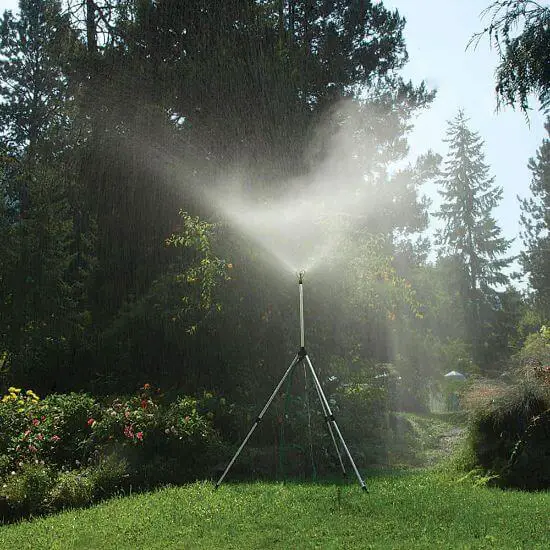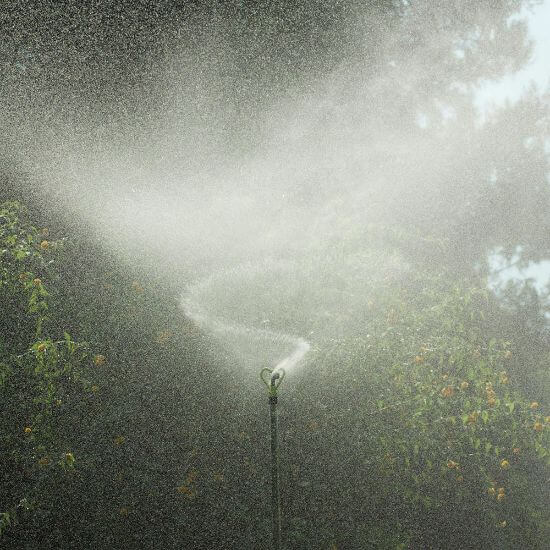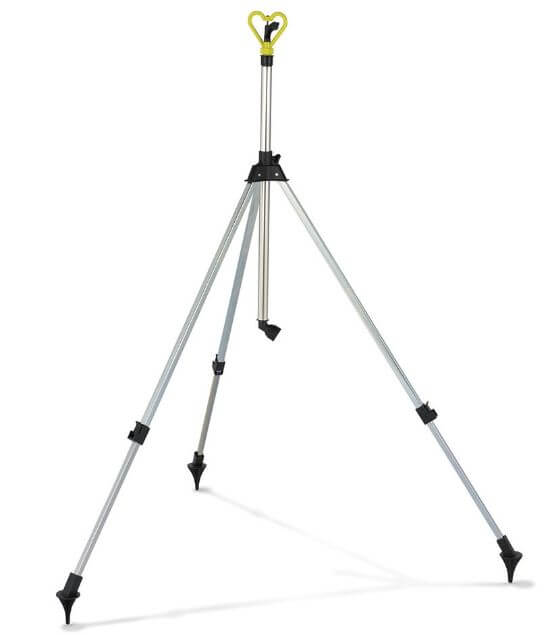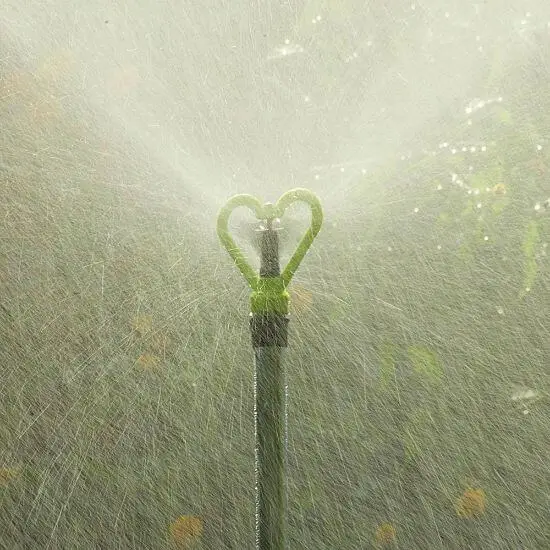This tripod sprinkler generates a wide-coverage spray that resembles a drizzle and uniformly hydrates plants while using one-third less water than conventional sprinklers.

The distinctive head of the sprinkler is shaped like a heart, and it disperses water in a fine mist rather than as large droplets. As a result, it won’t drown newly sown grass or delicate plants, nor will it cause puddles or runoff.

The sprinkler has a spray diameter that can be adjusted from 6 to 50 feet, has a coverage area of up to 1,900 square feet, and can operate with water pressure as low as 20 pounds per square inch.

Because it just has one moving part and none of the pinholes that are found on conventional sprinkler heads, it is significantly less likely to become clogged. As a result, it is an excellent choice for usage with hard water or well water.

The height of the rustproof aluminum tripod can be adjusted from 36 to 72 inches, and each leg can be raised or lowered individually. Moreover, the tripod has a ground stake that is 2 1/2 inches long for stability on uneven ground.
The frequency with which you should water plants depends on several factors, including the type of plant, its size, the environment it’s in, and the season. Here are some general guidelines to help you determine how often to water your plants:
- Check the soil: The best way to determine if a plant needs water is to check the soil. Stick your finger about an inch into the soil. If the soil feels dry, it’s time to water the plant. If it still feels moist, wait a few more days before watering.
- Consider the type of plant: Different plants have different water requirements. For example, succulents and cacti can go for long periods without water, while ferns and tropical plants require more frequent watering.
- Size of the pot: The size of the pot is also an important factor to consider. Smaller pots dry out faster than larger ones, so plants in smaller pots may need to be watered more often.
- Environment: The temperature and humidity of the environment also affect a plant’s water needs. Plants in hot, dry environments will need more water than those in cooler, more humid environments.
- Season: During the warmer months, plants generally need more water than they do in the winter. However, during the winter months, plants may need more water if the air inside is dry due to heating.
In general, it’s better to underwater plants than to overwater them. Overwatering can lead to root rot and other problems. It’s also a good idea to water plants in the morning or evening when temperatures are cooler and the sun isn’t as intense. This helps prevent water from evaporating too quickly and ensures that the plant has enough time to absorb the water it needs.
The mist tripod sprinkler is a versatile and efficient tool designed to provide gentle and even watering for a variety of outdoor spaces. With its adjustable height and misting capabilities, this sprinkler offers excellent coverage and is particularly well-suited for watering delicate plants, seedlings, flowers, and gardens.
The main feature of the mist tripod sprinkler is its adjustable height. The tripod design allows users to extend the sprinkler’s height to the desired level, ensuring optimal coverage for different plant heights or garden layouts. This adjustability feature is particularly useful when watering taller plants or when you want to avoid water spray hitting the foliage directly.
The misting function of the tripod sprinkler provides a fine spray of water droplets, creating a gentle and misty shower. This type of watering is ideal for delicate plants that are sensitive to heavy water pressure or direct streams of water. The misting effect mimics natural rainfall, providing a soft and nurturing watering experience for your plants without causing damage.
The tripod sprinkler typically has a rotating head that allows for 360-degree coverage. This ensures that water is distributed evenly across the designated area, promoting healthy growth and preventing dry patches. The adjustable spray pattern further enhances its versatility, allowing you to customize the watering radius and direction based on your specific watering needs.
Setting up the mist tripod sprinkler is usually straightforward. The tripod legs provide stability and can be easily positioned on various surfaces, including grass, soil, or even uneven terrain. The sprinkler head attaches to the tripod and can be adjusted to the desired height and angle for optimal coverage. Some models may also feature a flow control valve, allowing you to adjust the water pressure according to your watering preferences.
The mist tripod sprinkler is not only efficient but also water-conscious. The misting action creates smaller water droplets that have a higher chance of being absorbed into the soil rather than evaporating. This can help minimize water waste and increase water efficiency, particularly in areas with hot and dry climates.
When using a mist tripod sprinkler, it’s important to consider the water requirements of your plants and adjust the watering schedule accordingly. Factors such as soil type, weather conditions, and plant species will influence the frequency and duration of watering. It’s recommended to monitor the soil moisture levels regularly and make adjustments as needed to ensure optimal plant health.
In summary, the mist tripod sprinkler is a versatile and effective tool for gentle and even watering. With its adjustable height, misting capabilities, and 360-degree coverage, this sprinkler is ideal for watering delicate plants, seedlings, flowers, and gardens. The misting action mimics natural rainfall, providing a nurturing watering experience while minimizing water waste. By utilizing a mist tripod sprinkler, you can promote healthy growth and maintain vibrant outdoor spaces with ease.

